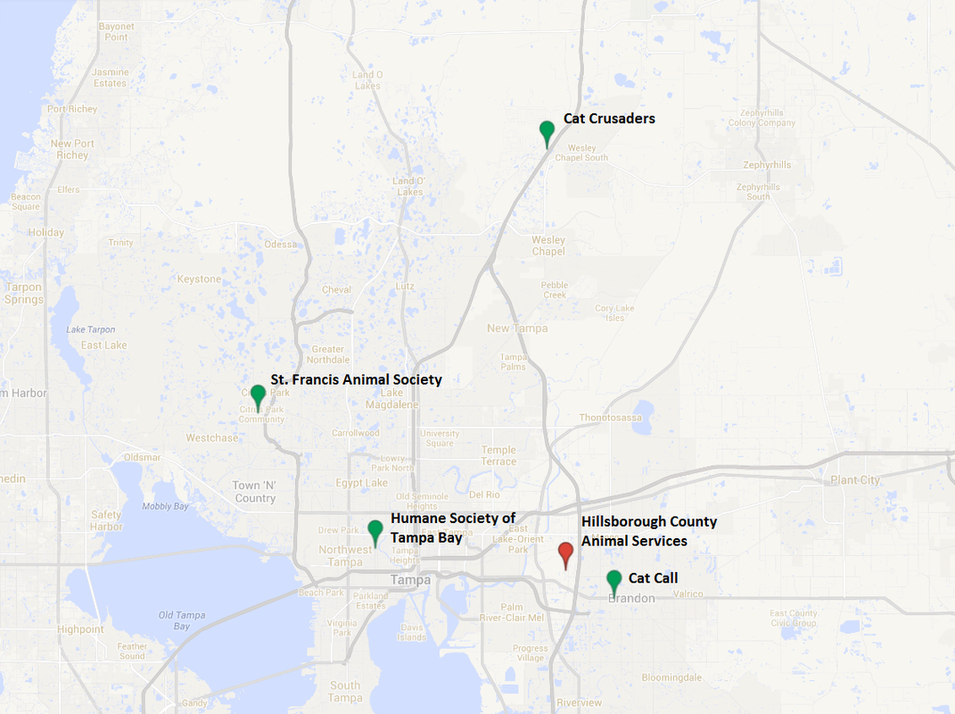What is Adopt-To-Rehome?
Adopt-To-Rehome is a pilot program at Hillsborough County Animal Services that is being re-introduced in order to help save more lives. It was originally launched in January 2013, but was discontinued after several months due to a lack of resources to properly manage the program. After much anticipation and planning, the long-awaited reintroduction is here! If the pilot program is a success, Adopt-To-Rehome will be expanded to include more rescues and possibly higher adoption limits, all of which could result in thousands more saved. The key to the program's success will be the RESPONSIBLE pulling and rehoming of cats and kittens, following the guidelines set out in the Adopt-To-Rehome Program Rules.
How the Program Works
Anyone not already fostering for one of the participating rescue groups is welcome to participate in this program. (If you already actively foster for one of these rescue groups, contact your foster coordinator for questions pertaining to participation in Adopt-To-Rehome.) The program itself is very simple:
STEP 1: Select one or two cats at a time you wish to adopt with the intention of rehoming.
STEP 2: Market the kitties on your own using a variety of adoption resources (e.g., friends, family, social media, flyers, adoption events)
STEP 3: Once you find an adopter, contact a participating rescue to have them finalize the adoption process.
STEP 1: Select one or two cats at a time you wish to adopt with the intention of rehoming.
STEP 2: Market the kitties on your own using a variety of adoption resources (e.g., friends, family, social media, flyers, adoption events)
STEP 3: Once you find an adopter, contact a participating rescue to have them finalize the adoption process.
Step 1: Select cats
Adopters may select up to two cats at a time to rehome. (View our Urgent Cat albums on Facebook.) There is no limit to the number of cats you can adopt per year for rehoming, as long as program rules are followed. The regular adoption fee must be paid on the first two selected, but subsequent fees will be waived for the life of the program. The adopter is legally responsible for the cats and must provide food, water, shelter and any necessary medical care. These costs will not be reimbursed.
You should plan to isolate your new cats from your resident cats for a minimum 10-day quarantine period, even if the new cats are not showing any symptoms of illness. Shelter cats are exposed to a variety of germs and a mandatory quarantine is the best way to ensure your resident cats don't get sick. During this time, be careful to wash your hands after petting your new cats and be sure to keep items such as food/water dishes, toys, cat beds and linens separate from your resident cats to avoid the spread of germs. While dogs cannot get sick from cat germs, it is a good idea to keep all resident pets away from the new cats to minimize the spread of germs.
You should plan to isolate your new cats from your resident cats for a minimum 10-day quarantine period, even if the new cats are not showing any symptoms of illness. Shelter cats are exposed to a variety of germs and a mandatory quarantine is the best way to ensure your resident cats don't get sick. During this time, be careful to wash your hands after petting your new cats and be sure to keep items such as food/water dishes, toys, cat beds and linens separate from your resident cats to avoid the spread of germs. While dogs cannot get sick from cat germs, it is a good idea to keep all resident pets away from the new cats to minimize the spread of germs.
Step 2: Market cats
You can begin marketing your newly adopted cats right away or you may choose to wait until the quarantine period is over. In most cases, the speed with which you are able to rehome your cats is proportional to the amount of time you spend marketing them. Friends and family are great initial resources to help you get the word out about your cats. You can also put up flyers in community locations where permitted, such as your church, activity club or even local shops (with owner permission). Social media is another great resource, with the potential to reach a wide audience. Social media sites like Facebook allow friends to share pictures and/or video of your cats quickly and easily. Video is one of the most powerful tools in helping find potential adopters. A picture might be worth a thousand words, but a video is worth a million!
Step 3: Rehome cats . . . and Repeat!
Once you have found a potential adopter, you must contact a participating rescue in your area to finalize the adoption (see map below). There are currently four rescues participating, but the goal is to expand the number of rescues over time. You are encouraged to work with the rescue closest to you, but you can choose anyone you want. The rescue's foster coordinator will help you arrange a date/time to bring your cat to their local adoption center. Ask the potential adopter you found to meet you at the adoption center and fill out the rescue's adoption form. Adoption fees will be paid directly to the rescue, and rescues have the right to refuse an adoption to anyone who doesn't meet their quality standards (this helps protect the cats). After the adoption is finalized, the rescue will certify to the shelter that you have successfully rehomed the cat and you will be free to adopt another cat to rehome, if you choose. You may have up to two cats in the program at any given time, but the total number is unlimited.

